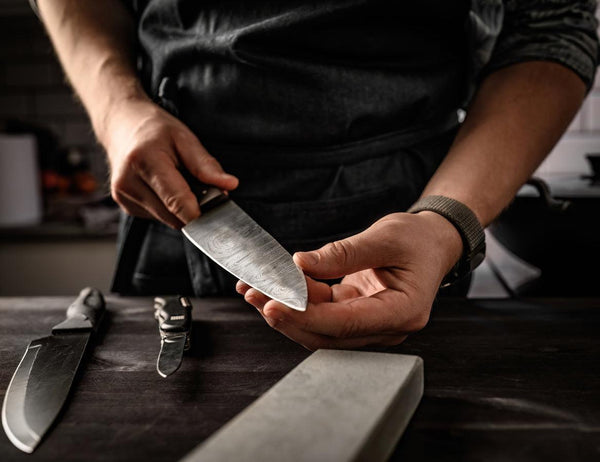
Jump to:
Whether you're a home cook or a professional chef, having a high-quality chef's knife is essential for efficient and safe food preparation.
The knife market is rather flooded with a variety of choices, both in knife styles and functions as well as country of origin. Here at Japanese Taste, we’re big fans of the notion of “quality” found throughout Japan’s culture, and that dedication to quality extends to a proud tradition of Japanese knife making.
That’s why we encourage you to look at Japanese chef’s knives, when selecting the tools of your trade or hobby. Well worth the small investment, Japanese knives will help you prepare and execute delicious and memorable meals, at home and in the restaurant.
Why Are Japanese Knives A Good Choice?

Japanese knives have gained a well-deserved reputation for their superior craftsmanship, razor-sharp edges and exceptional performance. There are many compelling reasons why you should consider investing in a Japanese knife.
Superior Knife-Making Craftsmanship
Japanese knife makers have been perfecting their craft for centuries, and their knives are renowned for their exceptional quality. Each knife is meticulously crafted using traditional techniques, ensuring that every blade is a work of art.
Think about what goes into preparing Japanese cuisine. Whether it’s sushi, ramen, tempura, stir-fry dishes, meats, fish, vegetables and more, presentation is as much a part of food here as is the execution itself.
A well-made Japanese chef knife helps ensure a proper cut every time, delivering on that presentation factor that will wow your customers, guests, family or self with every meal.
Razor-Sharp Edges
Japanese knives are made from high-quality steel that can be honed to an incredibly sharp edge. This razor-sharpness allows for precise and effortless slicing, dicing and chopping, making food preparation a breeze.
Not only is prep time reduced thanks to your Japanese chef’s knife, you’re getting superior cutting performance that’s visible in the results (as mentioned above).
Lightweight & Well-Balanced Knives
Japanese knives are designed with a sleek and lightweight profile, yet they are perfectly balanced for optimal control and maneuverability. This reduces fatigue during extended cooking sessions, allowing you to work with precision and ease.
For someone cooking 8, 10 or 12 hours a day, the fatigue factor is real. This applies to home cooks as well. The last thing you need is the tools of your trade (or hobby) slowing down or tiring you out.
Japanese Knives are Highly Versatile
While Japanese knives are traditionally designed for specific tasks, such as the nakiri for vegetables or the yanagiba for slicing fish, many modern Japanese knives are versatile enough to handle a wide range of kitchen tasks. This makes the high-quality Japanese knife a valuable addition to any cook's arsenal.
Two major types of =Japanese knives are Gyuto and Santoku knives. Santoku knives are a versatile kitchen knife offered in a variety of sizes and brands. Gyuto knives, meanwhile, are Japan’s version of chef’s knives.
By choosing a Japanese knife, you're investing in a high-quality tool, one backed up by a cultural tradition of quality knife-making with meticulous attention to detail.
What Do You Want To Achieve With Your Chef's Knife?
When it comes to selecting a Japanese chef's knife, it's essential to consider the specific tasks you'll be using it for.
Japanese knives are often designed with specific purposes in mind, and understanding these nuances can help you choose the right tool for the job.
Different Japanese Knife Types for Different Tasks

Japanese knife makers have developed a wide range of knife styles, each tailored to specific culinary tasks.
For example, the nakiri knife is designed for precise vegetable chopping. The yanagiba knife, meanwhile, is perfect for slicing fish and sashimi.
Rather than bringing a one-knife-fits-all approach, Japan’s knife makers and users know that every task has its knife. This means a small, upfront investment in quality Japanese chef knives, but one that will pay off for years in the form of well-prepped and executed meals that not only taste great but look fantastic.
Nakiri: The Japanese Knife for Vegetables

The nakiri knife, with its straight blade and squared-off tip, is an excellent choice for precision vegetable cutting.
Its flat profile allows for clean, even cuts, making it ideal for julienning, dicing and mincing vegetables.
Petty Knife for Small Tasks

If you're looking for a versatile knife for smaller tasks in the kitchen, consider a Japanese petty knife.
These compact knives are perfect for trimming, deveining and peeling, as well as delicate garnishing and food plating.
The Different Types Of Steel Used for Japanese Knives

The steel used in the blade's construction is a crucial factor in determining the performance and longevity of a Japanese knife.
Here's a breakdown of the different types of steel commonly used.
Stainless Steel
Stainless steel knives are resistant to rust and corrosion, making them a low-maintenance option. However, they may not hold an edge quite as well as other steel types and can be more challenging to sharpen.
If you’re going for cost performance, stainless steel knives deliver a pretty good value for the home cook.
High Carbon Steel
High carbon steel knives are known for their exceptional edge retention and ability to achieve a razor-sharp edge.
It’s true that carbon steel Japanese chef knives are somewhat more susceptible to rust and require more frequent maintenance (such as oiling and careful cleaning), the time spent is another investment in superior tools of the trade.
Professional chefs love high carbon steel knives from Japan, well aware of the quality and tradition that these Japanese chef knives bring to the kitchen. Many home cooks also swear by these higher-end knives.
Hybrid Stainless + Carbon Steel
Some Japanese knives are made with a combination of stainless and carbon steel, offering the best of both worlds. These “happy medium” Japanese chef knives offer middle-of-the-road value and performance.
The core is typically constructed from high carbon steel for edge retention, while the outer layers are made of stainless steel for rust resistance.
Particularly for specialty knives that you might not be using as frequently as the big guns in your chef knife arsenal, mixed stainless-carbon hybrid knives can be a good choice.
Get A Grip: Why Knife Handles Matter

Does the handle of the chef's knife really matter?
It sure does!
The handle of a Japanese chef’s knife is not just a functional component; it's also a reflection of the knife's aesthetics and cultural lineage. Understanding the differences between Japanese and Western knife handles can help you choose a knife that feels comfortable and balanced in your hand.
Japanese Knife Handles
Traditional Japanese knife handles, known as “wa-handles,” are typically made from wood, such as magnolia or “honoki” wood. These knives are designed to be cylindrical and smooth, allowing for a secure and comfortable grip.
Japanese knives were traditionally demanded and designed by chefs and Japan’s culinary artisans. They incorporate ergonomically superior features that allow both chefs and home cooks to feel comfortable while cutting and cooking.
Western Knife Handles
Western knife handles, often referred to as yo-handles, are typically designed with a more pronounced curve and contoured shape. They may also incorporate materials like synthetic resins or even metal for added durability.
These knives have a decent grip but ultimately, for many chefs and home cooks, western chef knives can seem lacking in the areas of bulkiness and balance.
How To Store Your Japanese Chef Knives Properly

Proper storage is crucial for maintaining the sharpness and longevity of your Japanese knives. Here are some tips to ensure your knives stay in top condition:
Importance of Proper Storage
Storing knives improperly can lead to dulling, chipping or rusting of the blade.
Therefore it is essential to find a storage solution that protects the blade while also keeping it accessible for use.
Storing Japanese Knives in a Knife Block
A knife block is a popular and convenient way to store Japanese knives. It fits well on the kitchen counter – and, as a bonus, always looks attractive to guests and family members at home.
Look for blocks with slotted inserts specifically designed for Japanese knives, as they often have a different blade angle and thickness than Western knives.
Using a Chef’s Knife Roll or Sheath
For added protection and portability, consider investing in a knife roll or individual sheaths.
These storage options help keep your blades clean and safe, as well as making it easy to transport your knives to cooking classes, food excursions or other culinary adventures.
Trust A Japanese Chef’s Knife For A Lifetime Of Quality

Choosing the right Japanese chef's knife can be a game-changer in your culinary endeavors.
With their superior craftsmanship, razor-sharp edges and exceptional balance, Japanese knives offer a level of precision and efficiency to elevate your cooking experience.
By understanding the different types of knives, steel and handles, you can select a Japanese knife that not only meets your specific needs but also aligns with your personal preferences and cooking style.
Want to know which knife sharpener to pair with your Japanese knife? Check out this article.
A quality Japanese knife is an investment that will pay dividends in the kitchen for years to come.


0 comments